|
|
 |
 |
|
|
FEATURESYoung Lions of CinemaTwo teams of College alumni bring Murderball, Man Push Cart to screenBy Jonathan Lemire ’01Quadriplegic rugby players fiercely battling each other on international stages. A Pakistani immigrant quietly pushing his coffee cart through the darkened streets of New York City. Two very different subjects of two very different films, yet the seemingly unrelated cinematic ventures have something in common beyond critical acclaim and prestigious film festival appearances. Both celebrated projects were spearheaded by teams of young filmmakers who are College alumni. “There’s no question that Columbia provided more than just
the training needed to make films,” says
Ramin Bahrani ’96, who wrote and directed Man Push Cart. “It
also helped install the spirit.” It is the result of the efforts of three men who met as first-year floormates in the John Jay residence hall: Bahrani and two of the film’s producers, Pradip Ghosh ’97 and Nick Bentley ’97, ’02 Business. On the other hand, Murderball, which was in theaters last summer and received an Oscar nomination in the “Documentary Feature” category, follows a group of hard-living and often hard-partying men who channel their aggression about their partial paralysis into full-contact rugby. 
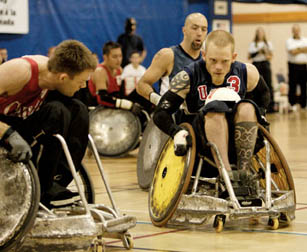
A scene from Murderball (2005) PHOTO: THINKFilm 
Henry-Alex Rubin ’95 was one of the documentary’s co-directors, while Jeffrey Mandel ’96, ’03L, ’03 Business and Sara Cross ’95 were producer and associate producer, respectively, of Murderball, which is out on DVD. “Some of the [Columbia] film professors — including Annette Insdorf — know more about movies than most encyclopedias,” says Rubin. “She’s a wonderful person, still very much a part of my life. She and the school touched my life.” Like so many New York stories, the tale of the making of Man Push Cart began on the subway. It was early 2002 when Bahrani bumped into Bentley on the subway platform at 7th Avenue and 14th Street. Rarely having crossed paths since their time in John Jay, the classmates made plans to catch up and, before long, became roommates in a Williamsburg apartment. Within weeks, the pair reconnected with a third friend from their first year on the Heights, Ghosh. Movies dominated the discourse, particularly those of Martin Scorsese and French filmmaker Robert Bresson. In time, Bahrani began to discuss his idea, a movie he was determined to make. “The first time I told [Pradip] about Man Push Cart, he said to me, with no hesitation, ‘I want to help you make this film,’” says Bahrani. Bentley was in, too, and the new partners’ exhilarating and exhausting journey accelerated. The three had very different backgrounds. Bahrani, 30, a film major, was born in North Carolina and lured to Columbia by New York City, the Core Curriculum and the chance to take courses from Professor Hamid Dabashi in the Middle East and Asian Language and Cultures Department. 
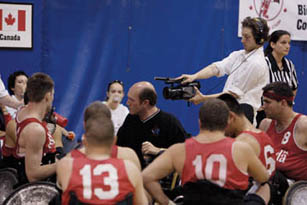
Henry-Alex Rubin ’95 shoots a scene as co-director of Murderball, which follows the personal stories of quadriplegics who play full-contact rugby. PHOTO: THINKFilm 
But films were his passion. He took advantage of Columbia’s program — particularly the tutelage of Professor Richard Pena, program director of the New York Film Festival — and successfully persuaded his graduate student friends to sneak him into the editing rooms. “I made a short film with a friend while at school, and I knew then that this is what I’m going to do, no matter who says it can’t be done,” says Bahrani, whose first two released works, the short Backgammon and the full-length Strangers, explored aspects of his Iranian heritage. Bentley, 30, who earned degrees in economics and English, hails from Baltimore and was drawn to Columbia by its proximity to the home of the Harlem Renaissance. Staying in New York after graduation and studying at the Business School, he worked at the Federal Reserve Bank before switching to Morgan Stanley. Ghosh, 29, was a math major who attended high school in India and was sold on the College by the energy and vitality of Columbia and its home city. He took a job with Lehman Brothers in New York after graduation, yet spent 15 months away from it traveling the Silk Road, the ancient 4,000-mile trade route that transverses China, Mongolia and Central Asia. “I read the books but wanted to see the places,” he said. “It was the experience of a lifetime.” Man Push Cart’s story came together for Bahrani soon after 9-11 as he watched the United States retaliate against terrorist strongholds in Afghanistan. He began thinking about the Afghani pushcart vendors he knew in New York and kept returning to the images of Camus’ Myth of Sisyphus, with its hero sentenced to an eternity of pushing a rock up a mountain only to see it roll back to the bottom each time he neared the peak. “I could see these men pushing those carts day after day,” he said. “I found that compelling, and I spent two years with these vendors, who are invisible to most New Yorkers, but had been journalists or engineers in their previous lives.” 
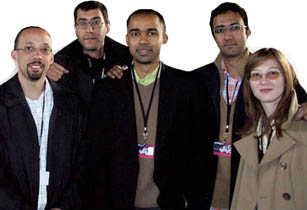
Members of the Man Push Cart production team attended the London Film Festival on October 22, 2005, including (left to right) Nick Bentley ’97 (producer), Ramin Bahrani ’96 (writer, director, producer), Pradip Ghosh ’97 (producer), Vinay Jayaram (executive producer) and Elena Kouvaros (costume designer). 
In the diverse neighborhood of Midwood, Brooklyn, Bahrani discovered his future star, Ahmad Razvi, serving coffee in a Pakistani sweet shop and soon asked the former vendor to make his film debut. “At first, he tried to be Brando, but once he was himself, he was brilliant,” Bahrani says, laughing. Bahrani and his team set out to make a movie that would capture the extreme wealth of Midtown’s glass towers and the extreme poverty of the homeless who sleep in their doorways after dark. However, they needed a half-million dollars to turn their vision into a reality, no small amount considering that the film they began making in 2004 had no sex, no gunplay and few trained actors. The money was raised through private equity sources, primarily investment bankers or hedge fund managers who the producers knew or got to know through networking. But Ghosh and Bentley’s roles were hardly limited to financing. “We were reading the script or going over the dailies or going to the set,” says Ghosh, “and then we slept an hour and went to work. It was exhausting and all-consuming, but completely worth it now that we’ve lived to tell the tale.” “When it was done and we started showing it, the first thing that made me happy was that people didn’t just get up and walk out,” said Bentley, laughing. “We could see the reactions of the people who watched it and knew we had something.” Being hailed for its unique depiction of New York City and dignified look at its forgotten residents, the film has been screened at scores of film festivals, including Venice, London and Sundance. It will go into wider release later this year. “The accolades have at times been overwhelming,” says Bahrani, whose next two projects feature Senegalese taxi drivers in his hometown of Winston-Salem, N.C., and then a brother and sister who work at an automotive chop shop in Queens. “But what perhaps hit home the most,” continues Bahrani, who plans to work with Bentley and Ghosh again, “was a friend who said he saw the film and the next day began talking to the pushcart vendor at the corner.” 
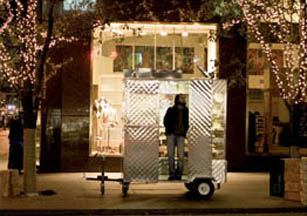
Man Push Cart captures a night in the life of a former Pakistani rock star who now sells coffee from his push cart on the streets of Manhattan. PHOTO: JON HIGGINS 
The genesis of Murderball lay in a moving Spin magazine article written by Dana Adam Shapiro, who brought the idea of a film based on the piece to his friend, budding director Rubin. The subject matter is nothing short of awe-inspiring: men from all over the world who lost at least partial use of their limbs due to some sort of calamity, whether it was a gunshot wound, a car wreck or dangerous bacteria. Yet, despite the hardships inherent to being confined to a wheelchair, these men haven’t given up their will to live. Instead, they play rugby. And they play it hard. “This story is not completely easy for people to hear or to see,” notes Mandel, who says the team decided early on to portray the hard-charging and often-crass lifestyle of the players who sometimes looked — and partied — like rock stars. “But it was too compelling to ignore.” Rubin, the son of art historian James Henry Rubin, split his time growing up between Paris and New York before enrolling at Columbia as a film studies major. He didn’t limit himself to undergraduate classes, though, instead diving into graduate courses, where he befriended the likes of James Mangold, acclaimed director of Walk the Line and Cop Land. “I snuck into all the grad film classes, which often wreaked havoc when the [teaching assistants] realized I had made a short film but wasn’t even officially registered,” he said. “Professor Insdorf, the head of the department, and I would sometimes have conflicts over the number of grad classes I was auditing, but in the end she let me get away with it.” While finishing at Columbia, Rubin put together his debut, Who is Henry Jaglom?, a documentary on a French filmmaker, before producing the rap documentary Freestyle and working as second unit director on Mangold’s Cop Land and Girl, Interrupted. During his years at Columbia, Rubin met Mandel and Cross but had no idea what roles they would play in his professional life. Mandel, a native Long Islander who majored in political science and earned his J.D./M.B.A. from the Law School and Business School, had become an attorney but was intrigued by a friend’s idea to start a movie production company. “I give Columbia some credit because it trains you to believe that you can do whatever you want,” said Mandel. “The whole idea is to make you an educated and well-rounded person, and this was a way for me to do something new and rewarding.” After being introduced to Rubin, Mandel agreed to use his business and legal experience as the film’s producer, but he knew he would need help to shoulder the heavy load. Enter Cross, a film studies major who made a well-received short, The Ride, after graduation and then earned her master’s at Oxford. Cross had started her own socially and environmentally conscious clothing line, coolnotcruel, and was looking to get back into films. For her, like Mandel, the Light Blue connection was the way into Murderball. 
“One day I was picking up Zupan in my old Ford ... the next day he was being driven around first-class.” 
“When Jeff sent me the bios for the team, I was looking at Rubin’s and it occurred to me I knew him at school,” Cross says. “We hadn’t seen each other in 10 years, and I only recognized his bio because of the documentary he made — Who is Henry Jaglom? — that he was talking about when in school. I didn’t remember his name, but I remembered that!” As with any documentary, no matter how great the concept, Rubin was initially uncertain there would be enough plot to carry the film, even as members of the crew packed their bags for the World Quad Rugby Championship in Sweden. “In documentaries, you don’t know the ending, so it’s high-risk. There have been plenty of projects that I have started but had to abandon because there wasn’t a ‘there’ there,” he says. “But it was clear we had a riveting topic at the get-go.” The action is furious and the characters vibrant. There is Joe Soares, a polio survivor and former Team USA rugby player, who believed he had been unfairly cut from the American team and instead took over the coaching reins of rival Team Canada. And there is Mark Zupan, who had fallen asleep in the back of a friend’s parked pickup truck when it lurched to life, sending him tumbling into a ditch. He saved himself from drowning by holding himself to a branch for 13½ hours but never regained the use of his legs. After a grueling shoot that captured several quad rugby events and the complicated personal lives of its participants, the film appeared at last year’s Sundance Film Festival and took the film community by storm — Murderball won the Documentary Audience Award and its stars were treated like celebrities on the festival’s party circuit. 
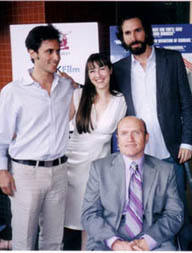
Cast and crew members gathered at the June 28, 2005, Los Angeles premiere of Murderball, including (left to right, standing) Jeffrey Mandel ’96 (producer), Sara Cross ’95 (associate producer), Dana Adam Shapiro (co-director) and (seated) actor Joe Soares. 
“We were stunned. Just a few days before winning the award, we came in with no idea what to expect,” says Rubin, who still works as an attorney. “Emotionally, that was the climax for us. After these guys [the rugby players] gave us so much of their lives, it was wonderful to bring them to Sundance and see them have a blast.” “It was like the floodgates opened,” adds Cross, who now is helping to produce a Discovery Channel feature documentary, 21 Up in America, with Michael Simmonds, who handled cinematography for Man Push Cart. “One day I was picking up Zupan in my old Ford and he was sleeping on an air mattress, and almost literally the next day he was being driven around first-class and staying at fancy hotels and appearing on Larry King and [Jay] Leno.” Backed financially by studios such as Paramount Pictures and MATV, the film opened in the United States last summer to rave reviews. While it did not quite do the box office business its creators had hoped, it is now on DVD, where they believe it will find a new audience. All three Columbia team members, who live primarily in New York City and don’t have any team projects in the works at this time, firmly believe the film has opened doors for them to work on high-quality future projects, including Rubin’s next film, a look at wounded soldiers coming from the conflict in Iraq. “We learned a lot, about a part of life and about ourselves,” Rubin said. “And I know I’m excited to see what’s next.” Jonathan Lemire ’01 is a frequent contributor to Columbia College Today and a staff writer for The New York Daily News.
|
|
|||||||||||||||||||||||||||||||||||||||||||||||||||||||